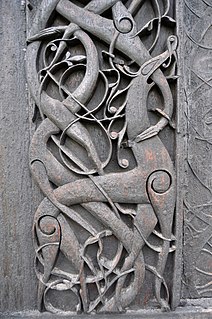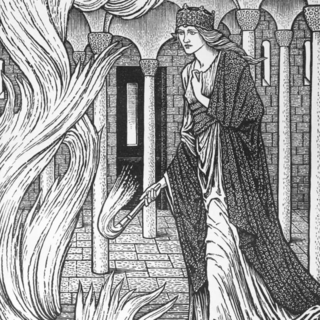See also
- Atlı, a Turkish surname
Atli is an Old Norse masculine personal name, and may refer to:

In Norse mythology, Asgard is a location associated with Gods. It appears in a multitude of Old Norse sagas and mythological texts. Some researchers identify Asgard as one of the Nine Worlds surrounding the tree Yggdrasil. Norse mythology portrays Asgard as a fortified home to the Æsir tribe of gods, located in the sky. Asgard consists of smaller realms that individually do not appear as frequently in mythological poems and prose. Ancient Norse eschatology envisages the total destruction of Asgard during Ragnarök, and its later restoration after the world's renewal. The best-known Gods of the Norse pantheon are Aesir or live in Asgard: Odin, Thor, Loki, and Baldr. Asgard is depicted as a celestial city of high towers surrounded by a great wall. Odin's famous hall of Valhalla, where his throne may have been located, is in Asgard.
"Edda" is an Old Norse term that has been attributed by modern scholars to the collective of two Medieval Icelandic literary works: what is now known as the Prose Edda and an older collection of poems without an original title now known as the Poetic Edda. The term historically referred only to the Prose Edda, but this since has fallen out of use because of the confusion with the other work. Both works were written down in Iceland during the 13th century in Icelandic, although they contain material from earlier traditional sources, reaching into the Viking Age. The books are the main sources of medieval skaldic tradition in Iceland and Norse mythology.

Höðr is a god in Norse mythology. The blind son of Odin and Frigg, he is tricked and guided by Loki into shooting a mistletoe arrow which was to slay the otherwise invulnerable Baldr.

In Norse mythology, Ragnarök is a series of events, including a great battle, foretelling the death of a number of great figures, natural disasters and the submersion of the world in water. After these events, the world will resurface anew and fertile, the surviving and returning gods will meet and the world will be repopulated by two human survivors. Ragnarök is an important event in Norse mythology and has been the subject of scholarly discourse and theory in the history of Germanic studies.

In Norse mythology, Rán is a goddess and a personification of the sea. Rán and her husband Ægir, a jötunn who also personifies the sea, have nine daughters, who personify waves. The goddess is frequently associated with a net, which she uses to capture sea-goers. According to the prose introduction to a poem in the Poetic Edda and in Völsunga saga, Rán once loaned her net to the god Loki.

In Norse mythology, Sif is a golden-haired goddess associated with earth. Sif is attested in the Poetic Edda, compiled in the 13th century from earlier traditional sources, and the Prose Edda, written in the 13th century by Snorri Sturluson, and in the poetry of skalds. In both the Poetic Edda and the Prose Edda, she is known for her golden hair and is married to the thunder god Thor.

The Poetic Edda is the modern name for an untitled collection of Old Norse anonymous narrative poems, which is distinct from the Prose Edda written by Snorri Sturluson. Several versions exist, all primarily of text from the Icelandic medieval manuscript known as the Codex Regius, which contains 31 poems. The Codex Regius is arguably the most important extant source on Norse mythology and Germanic heroic legends. From the early-19th century onwards, it has had a powerful influence on later Scandinavian literatures – not only through its stories, but also through the visionary force and the dramatic quality of many of the poems. It has also become an inspiring model for many later innovations in poetic meter, particularly in Nordic languages, offering many varied examples of terse, stress-based metrical schemes that lack any final rhyme but instead use alliterative devices and strongly-concentrated imagery. Poets who have acknowledged their debt to the Codex Regius include Vilhelm Ekelund, August Strindberg, J. R. R. Tolkien, Ezra Pound, Jorge Luis Borges, and Karin Boye.

Gudrun or Kriemhild is the wife of Sigurd/Siegfried and a major figure in Germanic heroic legend and literature. She is believed to have her origins in Ildico, last wife of Attila the Hun, and two queens of the Merovingian dynasty, Brunhilda of Austrasia and Fredegund.

In Norse mythology, the Nine Mothers of Heimdallr are nine sisters who gave birth to the god Heimdallr. The Nine Mothers of Heimdallr are attested in the Prose Edda, written in the 13th century by Snorri Sturluson; in the poetry of skalds; and possibly also in a poem in the Poetic Edda, a book of poetry compiled in the 13th century from earlier traditional material. Scholars have debated what being "born of nine mothers" implies and have sought to connect the notion to other European folk motifs. Scholars have theorized that Heimdallr's Nine Mothers may be identical to the Nine Daughters of Ægir and Rán, who personify waves. In turn, Heimdallr would be born of the sea.

Jörð is the personification of earth and a goddess in Norse mythology. She is the mother of the thunder god Thor and Meili, and a sexual partner of Odin. Her name is often employed in skaldic poetry and kennings as a poetic term for land or earth.

In Norse mythology, Surtr, also written Surt in English, is a jötunn. Surtr is attested in the Poetic Edda, compiled in the 13th century from earlier traditional sources, and the Prose Edda, written in the 13th century by Snorri Sturluson. In both sources, Surtr is foretold as being a major figure during the events of Ragnarök; carrying his bright sword, he will go to battle against the Æsir, he will battle the major god Freyr, and afterward the flames that he brings forth will engulf the Earth.

Alvíssmál is a poem collected in the Poetic Edda, probably dating to the 12th century, that describes how the god Thor outwits a dwarf called Alvíss ("All-Wise") who seeks to marry his daughter.

Tanngrisnir and Tanngnjóstr are the goats who pull the chariot of the god Thor in Norse mythology. They are attested in the Poetic Edda, compiled in the 13th century from earlier traditional sources, and the Prose Edda, written by Snorri Sturluson in the 13th century.

Hárbarðsljóð is one of the poems of the Poetic Edda, found in the Codex Regius and AM 748 I 4to manuscripts. It is a flyting poem with figures from Norse Paganism. Hárbarðsljóð was first written down in the late 11th century but may have had an older history as an oral poem.

Gundaharius or Gundahar, better known by his legendary names Gunther or Gunnar, was a historical king of Burgundy in the early 5th century. Gundahar is attested as ruling his people shortly after they crossed the Rhine into Roman Gaul. He was involved in the campaigns of the failed Roman usurper Jovinus before the latter's defeat, after which he was settled on the left bank of the Rhine as a Roman ally. In 436, Gundahar launched an attack from his kingdom on the Roman province of Belgica Prima. He was defeated by the Roman general Flavius Aetius, who destroyed Gundahar's kingdom with the help of Hunnish mercenaries the following year, resulting in Gundahar's death.

Atlakviða is one of the heroic poems of the Poetic Edda. One of the main characters is Atli who originates from Attila the Hun. It is one of the most archaic Eddic poems, possibly dating to as early as the 9th century. Owing to its stylistic similarity to Hrafnsmál it has been suggested that the poem might have been composed by Þorbjörn Hornklofi. It is preserved in the Codex Regius and the same story is related in the Völsunga saga. In the manuscript the poem is identified as Greenlandic but most scholars believe that this results from a confusion with Atlamál. The metre of the poem alternates irregularly between málaháttr and fornyrðislag. This may be an indication that two or more original poems have been merged or that the short and long lines were not felt as constituting two different metres at the time the poem was composed.

Þrymskviða is one of the best known poems from the Poetic Edda. The Norse myth had enduring popularity in Scandinavia and continued to be told and sung in several forms until the 19th century.
Guðrúnarkviða III, The Third Lay of Gudrun, is a short Old Norse poem that is part of the Poetic Edda. It has not left any traces in Völsunga saga and was probably not known by its compilers.
Guðrúnarkviða I, II and III are three different heroic poems in the Poetic Edda with the same protagonist, Gudrun.
Atli or variation, may refer to: